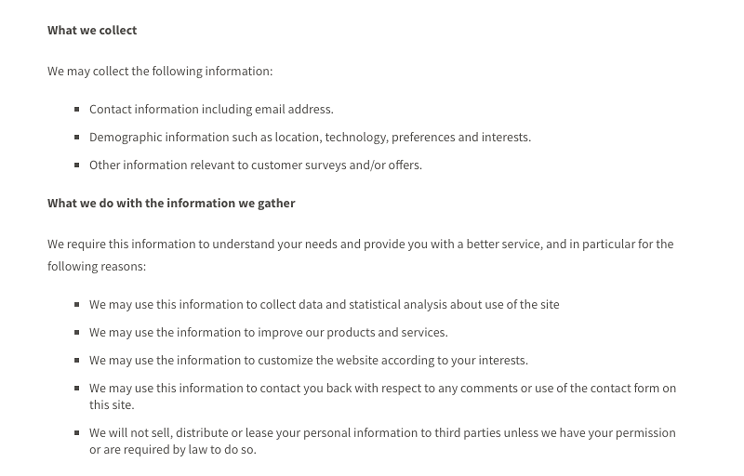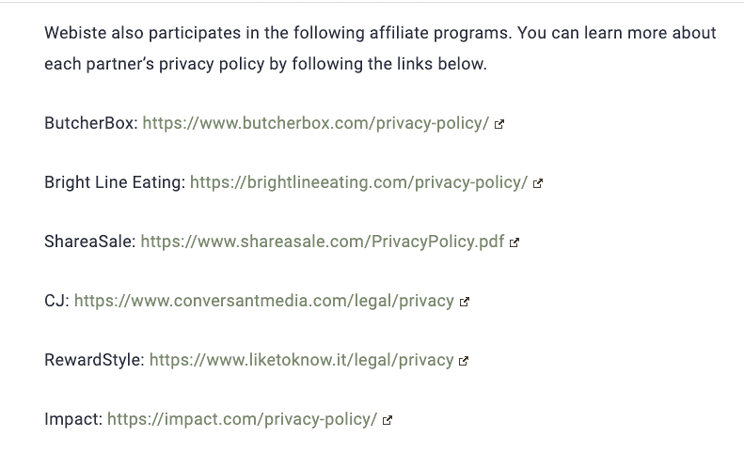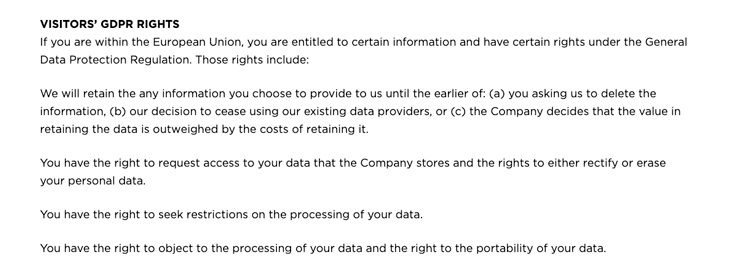How To Write A Blog Privacy Policy
If you operate a blog, it's essential that you provide a privacy policy that complies with applicable privacy regulations. A blog privacy policy protects your visitors' privacy rights and shields your blog from legal penalties.
Even though blogs aren't as data-driven as some businesses, most blogs still collect personal information for analytics or marketing purposes. If this applies to your blog, you most likely need a privacy policy.
Read on to find out what a blog privacy policy is, whether you need one, and how to create one.
- What Is a Blog Privacy Policy?
- Do I Need a Privacy Policy for My Blog?
- What to Include in a Blog Privacy Policy
- Sample Privacy Policies for Blogs
- How to Create a Privacy Policy for a Blog
- Blog Privacy Policy FAQs
What Is a Blog Privacy Policy?
A blog privacy policy is a legal page on your blog that explains to users how your site collects and uses personal information.
It's crucial to ensure that your privacy policy meets the requirements of applicable state, federal, or global privacy laws, which depend on where you and your readers reside.
Personal information is any information that can be directly or indirectly linked to an individual. Some examples of personal information that blogs collect include:
- Names
- Email addresses
- Account sign-up information
- IP addresses
- Transactional data (e.g., billing information, payment details)
Your blog privacy policy should specify all the possible ways your site collects personal information. These include direct data collecting methods such as contact forms, email subscriptions, and social media sharing, or indirect methods such as analytics tools, payment platforms, and third-party cookies.
If your blog is monetized through ads or affiliate links, your privacy policy should also disclose your site's relationships with third-party providers and their data-handling processes. You may also need a blog disclaimer, such as an affiliate disclosure to let users know you get compensated for featuring companies' products on your blog.
Do I Need a Privacy Policy for My Blog?
You need a privacy policy for your blog if you collect personal information, as you may be subject to comply with global privacy laws such as the California Online Privacy Protection Act (CalOPPA), the California Consumer Privacy Act (CCPA), or the General Data Protection Regulation (GDPR).
You also need a privacy policy for Blogger sites, as they still fall within the scope of privacy laws. If you built your blog using WordPress, you need to include a WordPress privacy policy.
In addition to government laws, third-party services often require a privacy policy for blogs using their services. For example, Google Analytics requires a privacy policy that discloses your site's use of Google Analytics and its cookies.
Not only are privacy policies often required by global privacy laws, but your visitors also expect your site to have one. A privacy policy reassures visitors that you're diligent in protecting their data.
What to Include in a Blog Privacy Policy
The requirements for blog privacy policies vary slightly depending on which laws you're subject to comply with. In general, privacy policies for blogs should address the following:
- Information collection and use — Explain to users the type of personal information you collect and the purpose of that data collection.
- Third-party sharing — Disclose whether you share information with third-parties and whether you use any third-party services on your site.
- Cookie disclosure — Identify the types of cookies used by your blog.
- Protection of personal data — Reassure users that you've implemented security measures to safeguard their data.
- External links — Inform users that your website may link to external websites outside your control, and advise users to read the privacy policies of the external websites they visit.
- Users' rights — Lists the rights that users have over their data, such as how users can request to review, correct, or delete their data.
If your blog has visitors from the European Economic Area (EU Member States, Iceland, Norway and Lichtenstein) or Switzerland, your privacy policy needs to include GDPR provisions, including a cookie consent notice and the contact information of data processors.
The US also has notable privacy laws, such as CalOPPA, the California Consumer Privacy Act (CCPA), and the Children's Online Privacy Protection Act (COPPA). Among these laws, CalOPPA is the most relevant for bloggers, as the law applies to any website that collects personal information from California residents.
To comply with CalOPPA, your blog privacy policy needs to address how you handle do not track (DNT) requests, and how you will communicate changes and updates to your privacy policy with your readers.
Privacy laws around the world differ in their requirements for privacy policies. It's important to review the privacy policy requirements of the laws that apply to your jurisdiction when writing a blog privacy policy.
Where to Put a Privacy Policy On Your Blog
Once you create a separate page for your blog privacy policy, you should display it in prominent places on your site.
Examples of prominent places include:
- Website footer
- Sidebar
- Terms and conditions
You should also link to your privacy policy at places where you request to collect personal information, such as newsletter sign-up forms, contact forms, and account sign-up pages.
For example, food blog Ambitious Kitchen links to their privacy policy in the website footer and in their email subscription sign-up.

Your privacy policy needs to be in visible places so that users can easily find and review it.
Sample Privacy Policies for Blogs
Privacy policies for blogs will vary in content depending on the applicable privacy laws and your data collecting practices. Check out these privacy policy examples for blogs to get inspiration for the content and layout of your own blog's privacy policy page.
The Cooking Jar: Privacy Policy for Food Blog
The Cooking Jar's privacy policy outlines all the ways that the site collects personal information, including contact forms, user comments, subscriptions and cookies. They specify the types of personal information collected and what it's used for.

Follow this example by using simple language that's free of legalese to describe what, how, and why personal information is collected.
Umami Girl: Privacy Policy and Disclosure Page for Lifestyle Blog
Umami Girl's privacy policy and disclosure page describes how the site collects information directly through contact forms and indirectly through third-party services. There's also a section that details the site's use of cookies and how users can set cookie preferences.
In the disclosure section, the blog states that it's a member of the Amazon Associates Program, and outlines their relationship with third-party advertisers.

If you use third-party services or advertisers on your blog, link to their privacy policies, as seen in the example.
You can also combine blog disclosures and privacy policy onto one page, as this blog does. If you monetize your blog through the Amazon Associates Program, you will need to include an Amazon affiliate disclosure.
Nomadic Matt: GDPR Privacy Policy for Travel Blog
Nomadic Matt's privacy policy has a section dedicated to the GDPR, as the blog has visitors from the EU (even though the blog operates from the US).
The privacy policy lists users' rights to request to review and delete personal information, and includes the site owner's contact information.
The blog privacy policy also addresses privacy for minors, use of cookies, and third-party advertising.

If you have site visitors from the EU, you should include a section for GDPR provisions even if you don't operate within the EU, as shown in this privacy policy example.
How to Create a Privacy Policy for a Blog
Now that we've gone over what a blog privacy policy is, when you need one, and how to write one, let's review the main points:
- A blog privacy policy describes to users how your site collects and uses personal information.
- Privacy laws around the world, such as COPPA and the GDPR, require privacy policies for blogs that collect personal information.
- Third-party providers and advertisers often require a privacy policy if you use their services.
- Display your privacy policy in prominent places on your blog, such as in the website footer and on sign-up pages.
Create a privacy policy for your blog by using our free privacy policy generator. Fill in information about your business and data collecting practices to generate a custom privacy policy for your blog in minutes.
Alternatively, download our free privacy policy template and edit the policy to create a blog privacy policy from scratch.
Having a blog privacy policy allows you to comply with privacy laws and reassures users that you take data protection seriously. The sooner you add a privacy policy to your blog, the better it is for you and your readers.
Blog Privacy Policy FAQs
- Is it required to have a privacy policy on my blog?
How To Write A Blog Privacy Policy
Source: https://termly.io/resources/articles/blog-privacy-policy/
Posted by: murphytorat1997.blogspot.com

0 Response to "How To Write A Blog Privacy Policy"
Post a Comment